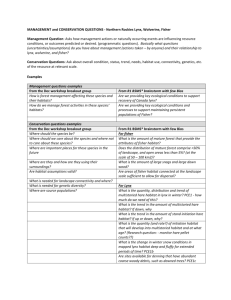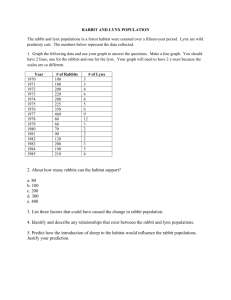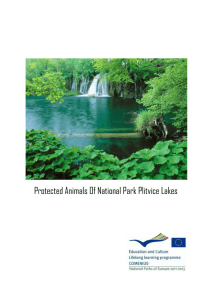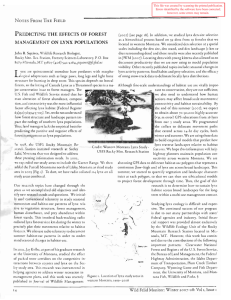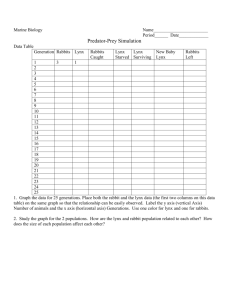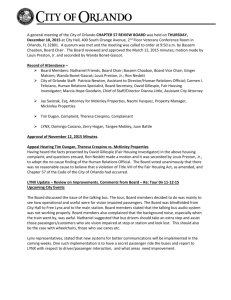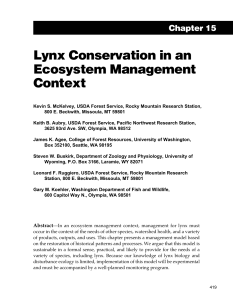Adaptive Implementation Strategy Clay Speas
advertisement
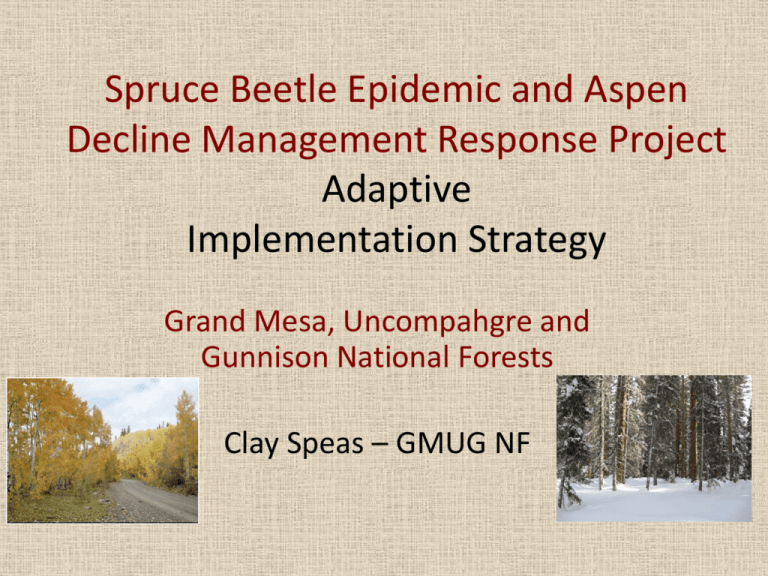
Spruce Beetle Epidemic and Aspen Decline Management Response Project Adaptive Implementation Strategy Grand Mesa, Uncompahgre and Gunnison National Forests Clay Speas – GMUG NF Why an Adaptive Strategy? • Extensive acres affected from Spruce beetle and Aspen Decline. Acres Affected (aerial detection) 250,000 spruce-fir since (2001-2013) - growing 238,000 acres aspen decline since (2000-2010) - stable • Site conditions change rapidly – Normal NEPA process takes 2+ years to complete – Green stands Dead/dying stands – Beetle behavior dynamics: Eruptive vs Inundative • Interdisciplinary Team involvement in project planning and implementation. • Creation of a collaborative learning environment Adaptive Implementation Strategy - Assumptions • Prescriptions and design features – commonly used in the past • Works within the Southern Rockies Lynx Amendment Framework. “caps” for vegetation management using exceptions/exemptions. Quantifies acres of vegetation management activities that do not require use of exemptions/exceptions. • Works within the framework of the 2010/2013 Programmatic Agreement for Bark Beetles, Hazard Tree and Prescribed Fire for cultural resources. • Relies on a feedback loop to Forest Leadership Team, stakeholders and regulatory agencies • Utilizes “plan, do, check, act” cycle linking strategic planning, tactical field operations, and reporting of outcomes for management action. Learning what we do well and recognizing we can do better! – Plan: ROD and project-level with ID Team – Do: Implement – Check: Sale administration, formal project-level reviews and on-going coordination amongst District staff. – Act: Forest Leadership Team Management Review Changes in onthe-ground management Complete Required Surveys Spruce-fir Structural Stand Conditions Resiliency Rx (< 40%) Stand multi-storied and averages ≥35% DHC and advanced regeneration are above mean snow depth. Single-storied Stand is multistoried and <35% DHC. Silvicultural Rx: Initiate UAM4 using ITS4 or group selection (<3 tree length – 0.25 to 2 acre openings). Removal centered on pockets of dead and dying. Harvest approximately 15 to 25% of the stand area with small openings tree lengths). Emphasis for group placement is in pockets of dead or dying trees. Individual tree selection will be conducted as needed to remove beetle affected trees in the matrix… Minimize or avoid to the extent practicable impacts to advanced regeneration during layout and operations. Focus on protecting high quality advanced regeneration (>35% DHC) in blocks of 0.3 acres or larger where it occurs. Lynx Habitat: suitable. Recovery and Resiliency Rx (40-90%) Stand multi-storied and averages ≥35% DHC4 and advanced regeneration are above mean snow depth. Silvicultural Rx: Remove all deaddying Spruce-fir and plant where adequate seed sources are lacking – Combination of Group Select where mortality is patchy to larger CC 4 where mortality is extensive. If needed, mechanical site preparation will be used to promote seed germination and seedling survival. If portions of the stand are less than 40%, create small openings (0.25 to 2 acres or <3 tree lengths) otherwise removal of the entire stand may be needed. Lynx Habitat: suitable. SRLA5: Stand is not multi-storied and therefore not subject to cap restrictions. SRLA5: Stand is not multi-storied and therefore not subject to cap restrictions Two-storied (multistoried under SRLA) Silvicultural Rx: Lynx Habitat: SRLA: Stand is multistoried and <35% DHC. Silvicultural Rx: Lynx Habitat: SRLA: Recovery Rx (>90%) Stand multi-storied and averages ≥35% DHC4 and advanced regeneration are above mean snow depth. Stand is multistoried and <35% DHC. Silvicultural Rx: Remove all deaddying spruce-fir and plant where adequate natural seed sources are lacking and when funds are available. Larger CC4 will be used where mortality is extensive. If needed, mechanical site preparation will be used to promote seed germination and seedling survival. Lynx Habitat: If 90% or greater of the over-story is dead or projected to be dead in two-years due to high levels of beetle infestation may be considered unsuitable lynx habitat if it lacks an live green understory To goal it to protect high quality >35% advanced regeneration to the maximum extent practicable. SRLA5: Stand is not multi-storied and therefore not subject to cap restrictions Silvicultural Rx: Lynx Habitat: SRLA: Appendix F – Design Features - Spruce Beetle Epidemic and Aspen Decline Management Response Project Objective: Use of a standard set of design features that will be applied to a project to minimize/avoid impacts. – Design Features – to address laws, regulations, Forest Plan direction – Many used on previous projects and proven to be effective. – Required resource surveys will be completed – Drive use of design features for protection of specified resources. – Project ID Team will complete project layout, including treatment units, location of roads, skid trails and landings, water influence zones, etc.. – The ID team will also identify applicable project design features that will be applied to the treatment area. Project Design Checklist Objectives: – Ensures Interdisciplinary Planning of the project. – Ensures all required surveys have been completed. – Mechanism to identify specific design features that should be applied to the project. – Links project design to provisions in the timber sale contract. – Identifies project-specific monitoring if needed. – Accountability • Forest Service Specialists and Line Officer sign-off. • Made available to stakeholders via Forest website. Project Design Checklist • ☒Wildlife and Fish Surveys • Northern goshawk/forest raptor surveys • Dense horizontal cover surveys (Canada lynx) • Etc. • Threatened, Endangered and Sensitive species ☐ – Applicable Design Features (list): 1. 2. 3. District Biologist Date: District Ranger Date: Monitoring – Project Review Objective: At least one project would be reviewed annually by a Forest ID Team – Implementation monitoring: were applicable Prescriptions and design features identified and implemented on the project. – Effectiveness monitoring: treatments implemented as designed and were design features effective Findings Report Recommendations: – Corrective actions if applicable surveys or design features were not implemented – Reduce or modify vegetation treatment operations – Modify resource protection measures – Identify if additional monitoring is needed to address an issue. – New information/science that may affect current management direction. Management Review Annual Review of “findings” by Forest Leadership Team – Approve, reject or modify recommendations of review team. – Mechanism to consider best available science, changes in agency policy or direction, or changed conditions (such as the US Fish and Wildlife Service listing a species as threatened or endangered). – Mechanism to modify prescriptions/design features. – Changed conditions or approaches scope and range of effects disclosed in NEPA exceeded. – ID Team review of NEPA documentation. – Correction, supplement or revision of the original decision as specified in FSH 1909.15(18.2). Annual Reporting to regulatory agencies • National Historic Preservation Act – Programmatic Agreement for Bark Beetles, Hazard Tree and Fuel Reduction Program and Prescribed Fire P.A. of 2010/2013. • Endangered Species Act - Southern Rockies Lynx Amendment and Programmatic Biological Opinion for the SBEADMR Project. • Clean Water Act – Storm water management (Forest Service BMP implementation/review) and 404 Permit (obtain as needed through life of project). Comments and Feedback • Overall process • Is it realistic? • Does it need to be modified to become more collaborative? • Where would you like to be included in the process? • Immediate comments on Design Features? • Immediate comments of Silvicultural Prescription Matrix? • Implementation Monitoring - stakeholder involvement? • Other suggestions/concerns?
